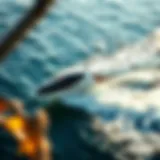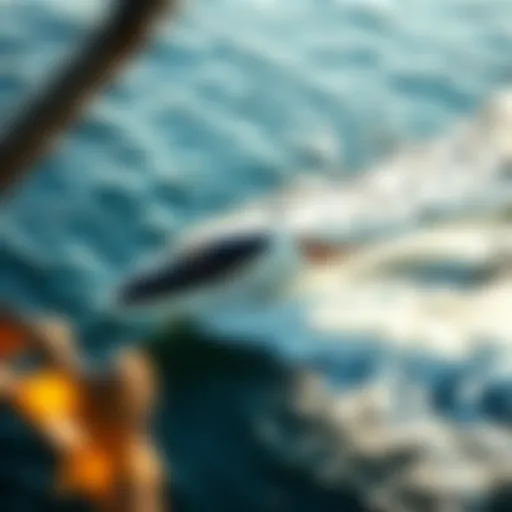Kite Surfing Adventures: Florida's Best Spots
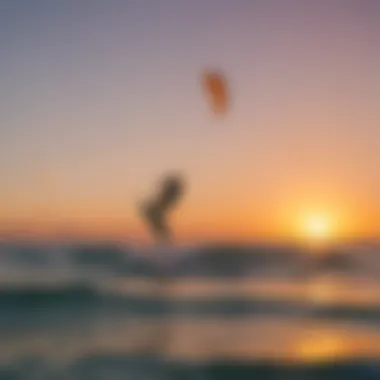

Intro
Kite surfing in Florida is more than just a sport; it’s a dance with the wind and the waves. The state, blessed with its beautiful coastlines, provides the ideal backdrop for practitioners ranging from beginners to experienced kiteboarders. As the sun glistens off the pristine waters, the joy of gliding over the surface is palpable, making it a prime location for enthusiasts.
In this journey, we will unpack the various dimensions of kite surfing in Florida. From gear selection to skill development, each element contributes to the holistic experience of this thrilling activity. Wherever you are on your kiteboarding journey, there’s always something new to learn and explore in this wide world.
Gear Selection
Selecting the right gear for kite surfing is crucial; it can make all the difference between a seamless ride or a frustrating experience. Here’s a look at the essential elements of your kit.
Types of Kites
The type of kite you choose will greatly influence your performance. Kites come in different shapes and sizes, catering to diverse weather conditions and riding styles.
- C-shaped Kites: These are designed for high performance and are ideal for advanced tricks and jumps. They provide excellent lift but require a higher skill level to handle.
- Bow Kites: Known for their versatility, bow kites are suitable for a variety of wind conditions, making them great for beginners. They have a larger wind range and are easier to relaunch.
- Delta Kites: These offer stability in difficult conditions and are perfect for lighter winds. Their unique shape allows for great upwind performance.
Choosing the right kite means understanding your own abilities and the conditions you'll be riding in. For instance, if you plan on primarily riding in Florida's warmer coastal winds, a bow kite may serve you best due to its adaptability.
Choosing the Right Board
The board is your second piece of vital gear. Selecting the right one can impact your control and performance significantly.
- Twin Tip Boards: These are the most common and suitable for all levels, offering great versatility for different riding styles. They allow you to ride in both directions, making your experience more flexible.
- Directional Boards: More aligned with surfing, these are meant for riding in one direction and are typically used in wave conditions. They require more skill to master but can yield excellent performance in the right hands.
- Foil Boards: These are perfect for those looking to ride the waves without the turbulent surface. They allow you to glide above the water, providing a unique experience.
When selecting your board, consider your weight, the type of kite you'll be using, and the conditions you expect to face.
Preparing your gear properly can be the difference between an exhilarating ride and a day dashed by frustration. Take the time to understand what works best for you.
Skill Development
Kite surfing isn't just about having the right equipment; it's also vital to cultivate your skills to enjoy the thrill fully and safely.
Essential Techniques
Starting with the basics is crucial. Mastering the fundamental techniques means having better control over your kite and board. Key practices include:
- Body Positioning: Keeping a balanced stance helps maintain control.
- Steering the Kite: Understanding how to direct the kite properly can influence your speed and direction.
- Practicing Water Starts: A crucial technique that every surfer should develop to transition smoothly from the water to the board.
These techniques form the foundation that will help you progress to more advanced maneuvers like jumps, tricks, or wave riding.
Progression Tips
As with any sport, practice makes perfect. Here are some tips to help you elevate your kite surfing game:
- Regular Practice: Finding time to ride consistently will naturally enhance your skills.
- Learn from Others: Watching seasoned kiteboarders or seeking help from an instructor can offer insights you might miss on your own.
- Stay Informed: The world of kite surfing is always evolving. Staying updated with the latest techniques, gear innovations, and local conditions can keep you ahead of the curve.
Kite surfing in Florida offers a unique chance to indulge in this exhilarating sport while honing your skills in picturesque surroundings. Whether it’s your first ride or you're trying to land that next big trick, Florida’s breezy beaches provide the perfect playground for all kiteboarders.
Understanding the Basics of Kite Surfing
Kite surfing, as thrilling as it is, stands firmly on the foundation of some essential principles and knowledge. Before one takes to the waters, it's vital to grasp the fundamental aspects of the sport. Knowledge leads to safety, enjoyment, and ultimately, proficiency. Engaging deeply with the basics sets the stage for a richer experience and mastery over challenging maneuvers.
Definition and History
Kite surfing combines elements of surfing, wakeboarding, and paragliding. To define it simply, it involves riding on a small board while being propelled across the water by a large, controllable kite. While kite surfing has gained immense popularity in recent decades, its roots stretch back to ancient times. Histories from the Asian Pacific reveal that kites were crafted for transportation and recreation. In the modern context, kite surfing began to take shape around the late 20th century. Notable developments in equipment, such as the introduction of inflatable kites and advanced control systems, sparked the sport's revolution in the 1990s.
Understanding this evolution offers insight into how kite surfing has grown into the vibrant community that exists today. The sport now captures the imagination of countless enthusiasts, each adding their own flavor to the practice.
Key Components of the Sport
The sport revolves around some core components that anyone interested in kite surfing must understand. Knowing these elements can make or break the experience on the water.
- Kite: The kite is the powerhouse of the sport. Ranging in size and design, the right kite can greatly influence the rider's performance and comfort level. Most kites are made of durable materials, built to withstand the windy and often harsh marine environments.
- Board: Whether it is a twin-tip board for a more versatile cruising experience or a directional board for wave riding, the choice hinges on the surfer’s style. Boards are typically lightweight, allowing for more agile movements on the water.
- Harness: Essential for transferring the kite's pull to the rider's body, the harness connects the rider to the kite via a safety line. Comfort and fit are paramount here, as a well-fitted harness enables better control and reduces fatigue during long sessions.
- Safety Equipment: This includes a quick-release system on the harness, a flotation vest, and a helmet. These components are not just accessories; they play a crucial role in ensuring that riders have a safety net in times of trouble.
Knowledge of these basic elements invites a deeper connection with kite surfing. They serve not only as tools but also as companions on the journey. As with any sport, the more familiar one becomes with their equipment and its history, the better prepared they are to embrace the exhilarating, sometimes unpredictable nature of kite surfing.
The Geographical Advantage of Florida
Florida's unique geographical characteristics offer a veritable playground for kite surfing enthusiasts. From its stunning coastlines to favorable wind conditions, the state's natural features contribute significantly to the kite surfing experience. Understanding these geographical advantages helps practitioners not only choose their spots wisely but also optimize their time on the water.
Diverse Coastlines
Florida boasts an extensive range of coastlines, each lending itself to different kite surfing experiences. You can find everything from the vibrant beaches of Miami to the serene waters of the Florida Keys.
- Atlantic Ocean vs. Gulf of Mexico: The Atlantic coast experiences more consistent and stronger winds compared to the calmer Gulf waters, making it ideal for more experienced kite surfers looking for an adrenaline rush. Conversely, the Gulf coast is more suitable for beginners, offering more stable environments with lighter winds.
- Variety of Scenery: The floribunda of landscapes found across Florida’s shores enhances the surfing experience. Surfers might catch the sunset over the Tampa Bay, or ride the waves with the scenic backdrop of palm-fringed beaches in Key West. This diversity makes every session unique, offering exhilarating vistas with each ride.
- Access to Flat Water: Alongside the traditional wave spots, Florida is home to numerous lagoons and bays that provide flat water riding opportunities. These locations often allow for smoother rides and are less affected by wind variations, making them ideal for practicing tricks or for new surfers learning the ropes.
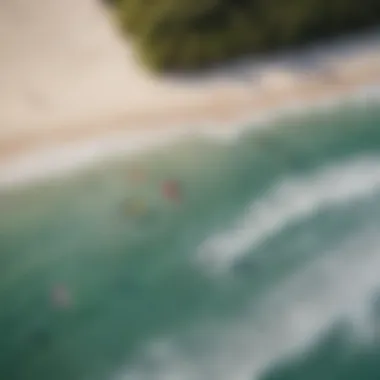

Wind Patterns and Seasonality
Wind patterns play a crucial role in shaping the kite surfing experience in Florida. Understanding when and where the winds blow can help surfers maximize their time on the water.
- Consistent Trade Winds: Florida benefits from trade winds, especially from April to November. These winds usually range from 12 to 25 knots. Kite surfers can take advantage of this predictable wind pattern, resulting in many successful days on the water.
- Seasonal Considerations: The summer months can present tricky conditions due to the influx of storms, thus increasing wind variability. Surfers should monitor weather patterns closely. Conversely, winter brings stronger winds and cooler temperatures, attracting experienced kiteboarders looking for exhilarating rides.
"Knowing the wind patterns is essential; it’s like reading the waves before you dive in."
- Local Microclimates: Florida isn’t just a flat land when it comes to wind; variations in elevation and local geography create microclimates. Seeking out lesser-known spots might yield better conditions, offering a quieter experience far removed from crowded beaches.
In summary, Florida’s geographical advantages – its diverse coastlines and favorable wind patterns – make it one of the prime destinations for kite surfing enthusiasts. Understanding these elements can help kiteboarders enhance their skills and enjoy an unforgettable experience on the water.
Popular Kite Surfing Locations in Florida
When it comes to kite surfing, location is often half the battle. Florida boasts some of the prime spots, attracting both seasoned practitioners and newcomers eager to catch their first wind. The combination of steady winds and vast, beautiful coastlines create an inviting playground for anyone with a kite and a board. Understanding these locations is crucial for assessing where one might practice their skills, challenge their limits, or simply enjoy a day on the water.
Beyond the thrill of riding the waves, the various locations offer unique experiences, from the visual grandeur of the Atlantic to the tranquil waters of the Gulf. Each spot has its own advantages and drawbacks, influenced by factors such as wind conditions, wave sizes, and local crowd levels.
Let’s take a closer look at some of the most popular kite surfing locations in Florida:
The Florida Keys
The allure of the Florida Keys goes beyond its laid-back island vibe. These isles provide some of the most scenic environments for kite surfing enthusiasts. The shallow waters around these islands help create more predictable wind patterns. Here, Key West stands out. With a natural barrier reef protecting the area, it results in flat water conditions, making it an ideal training ground.
Here are some key points:
- Smooth Winds: Consistently ideal wind conditions, often between 15 to 25 knots.
- Scenic Views: Hanging out amidst vibrant sunsets while kites dance in the sky is an appealing pastime.
- Varied Terrain: Different locations such as Cayo Hueso Beach and Smathers Beach offer both flat and choppy water for skills development.
Miami and Surrounding Areas
Miami isn't just a party hotspot; it's also a dynamic arena for kite surfing. Haulover Park is particularly well-known in the area. The site features long sandy beaches and wind conditions that cater to various skill levels. In addition, it becomes a gathering spot for kiteboarders, making it an excellent place to connect with other enthusiasts.
Important considerations include:
- Wide Beaches: Ample space to launch kites without feeling cramped.
- Social Scene: Plenty of opportunities to meet other riders, fostering a supportive community atmosphere.
- Accessibility: Proximity to amenities and infrastructure makes for hassle-free visits.
Tampa Bay Area
Tampa Bay adds a different flavor to kite surfing in Florida, with spots like Pass-A-Grille Beach and Treasure Island. The area tends to have consistent winds that attract varying skill levels. Moreover, the shallower waters in these locations afford beginners a safer learning environment, helping reduce the intensity of wipeouts.
Highlighting some advantages:
- Beginner-Friendly: Shallow waters make it safer for novices learning the ropes of the sport.
- Surrounded by Nature: Beautiful scenery, including swaying palms and sandy shores, provides an enjoyable backdrop for kite sessions.
Northeast Florida Coast
The Northeast part of Florida presents a different landscape, offering rugged beauty alongside its coastline. Jacksonville Beach stands out for its mixture of flat and choppy water, catering to various levels of skill. The winds here can be quite dependable, especially fall through spring.
Key elements to note:
- Challenging Conditions: More suited for experienced riders when conditions can kick up.
- Less Crowded: Compared to other locations; it feels less commercialized.
- Diverse Experience: The surrounding nature includes unique wildlife and scenic beach paths, enriching the overall experience for practitioners.
In summary, the kite surfing locations in Florida are as diverse as the state itself, providing myriad experiences tailored for every type of rider. Each site offers a unique flavor of required skills, social connections, and environmental beauty, ensuring that kite surfers never run out of new horizons to chase.
Essential Gear for Kite Surfing
When diving into the exhilarating world of kite surfing, having the right gear can make all the difference. Not only does it enhance your performance, but it also ensures safety while you ride those waves. In Florida, the unique conditions demand specialized equipment, making this section crucial for both novice and seasoned kiteboarders. This essential gear caters to various skills and preferences, and understanding each component can help you enjoy the sport to the fullest.
Selecting the Right Kite
The kite, being at the heart of kite surfing, requires careful selection. Different kites serve various wind conditions and rider abilities. The main types include inflatable kites, which are typically user-friendly and versatile; and foil kites, favored by experienced riders for their efficiency and indoor capabilities.
When choosing a kite, consider factors like:
- Size: Kites are often sold in square meters. Smaller kites are great for strong winds, while larger kites work well in lighter conditions.
- Wind Range: Each kite has a specific wind range it operates best in. Selecting a kite with a range that matches Florida's unpredictable winds can be beneficial.
- Skill Level: Beginners might prefer kites that are stable and easier to control, while experienced riders often look for performance-driven kites.
It’s smart to consult with local shops or seasoned riders in Florida to find recommendations suited for the coast's particular conditions.
Harness and Board Options
Next up is the harness, worn during kite surfing to connect the rider to the kite. A good harness plays a vital role in comfort and control. There are three common types: seat harnesses, waist harnesses, and vest harnesses. Seat harnesses distribute pressure on the hips and are great for beginners, as they provide a secure fit. Conversely, waist harnesses offer more freedom and are often preferred by advanced riders during tricks.
Board selection is equally crucial. The board’s size and shape can impact speed, stability, and maneuverability. Some key points to consider include:
- Size: Longer boards can deliver better upwind performance while shorter ones are typically more maneuverable.
- Shape: A board with a wider outline can provide more stability at slow speeds, which is beneficial for learning.
- Material: Boards can be made of fiberglass, wood, or carbon—each having different durability and weight benefits.
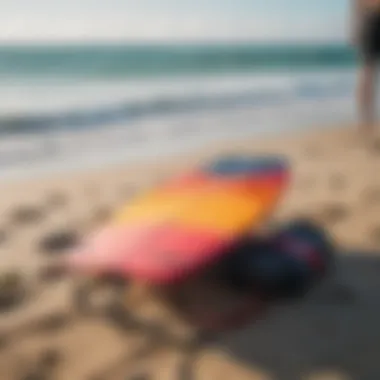

A solid combo of harness and board suited to your skill level will improve your experience significantly.
Safety Equipment
Safety shouldn’t take a backseat in kite surfing. Having the right safety equipment is as crucial as having a proper kite. Here are the fundamental safety items to consider:
- Helmet: A skateboard-style helmet provides head protection while riding, particularly in crowded spots.
- Impact Vest: Beyond buoyancy, vests can cushion falls, minimizing injury during crashes.
- Quick Release System: Ensuring your harness has a functional quick release mechanism can be a literal lifesaver during emergencies.
- Leash: This attaches the rider to the board, preventing it from drifting away.
For kite surfers, avoiding risks while enjoying this thrilling sport is paramount. The right gear, when paired with proper knowledge, leads to a safer and more enjoyable experience.
"Investing in good equipment pays off in performance and peace of mind—never skimp on safety."
Ensuring you have the correct gear before hitting the waters will allow you to focus on what truly matters: the thrill of kite surfing against the beautiful Floridian backdrop.
Mastering the Techniques
Mastering the techniques of kite surfing is fundamental not just for safety but also for enjoyment. The thrill one experiences while controlling a kite and gliding across the water is incomparable. Whether you're just starting or looking to level-up your skills, understanding the techniques can truly enhance your overall experience.
Fundamental Skills for Beginners
For those just dipping their toes into the world of kite surfing, there are several essential skills to master. First off, kite control is key. Beginners should focus on how to fly the kite smoothly and maintain steady power. Practicing basic maneuvers like the "figure eight" will help develop your skill in keeping the kite aloft without too much pull.
- Launching and Landing: Understanding how to launch the kite safely is crucial. Positioning yourself with the wind downwind of you helps balance power. Equally, landing the kite properly ensures you aren’t drawn into trouble.
- Heel to toe edge transition: Once up on the board, understanding how your body weight shift affects the board’s edge keeps you stable. It’s all about feeling the board beneath your feet.
Keep in mind that patience is vital. These skills won’t materialize overnight, but small, consistent sessions will yield positive results. Practicing on calm water with no waves can help ease the learning curve. The flat waters of Tampa Bay or certain spots in the Keys could be ideal for newcomers.
Advanced Maneuvers and Tricks
Once you’ve conquered the basics, it’s time to ramp up the excitement. Advanced maneuvers not only showcase your skills but offer a sense of freedom on the water. Tricks, such as jumps and aerial spins, take practice and precision.
- Jumping: To get airborne, you'll need to gather speed and then use a strong pull from the kite. Timing is everything; pushing down on the board while pulling up on the kite launches you into the air. As your skills progress, try tweaking mid-air rotations for added flair.
- Unhooked Tricks: Taking the harness off adds a new level of complexity. Techniques like the handle pass become a thrilling challenge that separates amateurs from seasoned surfers. Make sure to practice these tricks in a safe environment, ideally with the input of experienced peers or professionals.
Never forget to keep an open mind when learning. Watching fellow surfers or connecting via forums like Reddit can provide helpful tips or inspiration.
"The only limit to your impact is your imagination and commitment." – Tony Robbins
Mastering these techniques effectively combines determination and finesse. Embrace each challenge, celebrate your progress, and most importantly, enjoy riding those waves. Each session on the water, for both beginners and experts, is a step toward new heights in kite surfing.
Safety Protocols in Kite Surfing
When it comes to kite surfing, safety protocols are not just recommendations. They're essential practices that can make the difference between an exhilarating session and a dire incident. Understanding the risks is just as vital as knowing how to ride the waves, especially in a state like Florida, where conditions can change in the blink of an eye. The sport, while thrilling, carries inherent dangers, and whether you’re a novice or a pro, these protocols lay the groundwork for a safer and more enjoyable experience.
Understanding Kite Safety
Kite safety starts with a genuine understanding of how your gear operates. This knowledge transforms the rider from a mere participant into a proactive guardian over their own safety. Familiarizing oneself with the components of the kite, lines, and bar setup is crucial. Riders should routinely check for wear and tear on their equipment. Remember, a frayed line or a loose connection can lead to serious mishaps.
Here are some key safety tips for kite safety:
- Make sure your kite lines are untangled before launch to prevent accidents.
- Always conduct a pre-flight check, focusing on the integrity of your kite and gear.
- Be aware of your surroundings, such as other riders, boats, or beachgoers.
Knowing how to safely launch and land your kite cannot be overstated. Collaborating with a buddy during these moments can produce an extra safety net, even for seasoned kiteboarders. It’s also prudent to wear proper protective gear, including a helmet and impact vest, as they can shield you during unexpected falls or collisions.
Emergency Procedures
No one wants to think about emergencies while out kite surfing, but having a set of procedures can greatly enhance safety.
In case of an emergency, consider the following steps:
- Stay Calm: Panic can exacerbate any situation. Keep a clear head.
- Depower your kite: Knowing how to quickly depower your kite is paramount. The "quick release" feature on your control bar is your ally in limiting the kite's pull.
- Signal for Help: Use universally recognized signals, like waving your arms or calling for assistance, if you’re in trouble.
- Assess Your Position: If you’re in the water, notice your distance from the shore and any potential hazards nearby.
- Practice Self-Rescue: Learning how to self-rescue is vital. This means having the ability to use your board and kite to get back to safety if you’re separated from your gear.
"Preparedness is the key to minimizing risks; a kiteboarder who knows how to react can turn a potential disaster into a minor inconvenience."
Equipping oneself with these emergency protocols and understanding kite safety ensures that kite surfing remains a fantastic, fulfilling sport. Riders who integrate safety into their routine not only protect themselves but also foster a culture of care in the vibrant Florida kite surfing community.
Environmental Considerations
Kite surfing isn’t just about the thrill of gliding over the waves with a big colorful kite overhead; it’s also about respecting and understanding the environments that make this exhilarating sport possible. Florida's unique ecosystems host a diverse array of wildlife, plant life, and underwater habitats that can be easily disrupted if enthusiasts aren’t conscientious. One might say that the ocean is our playground, but like any playground, it requires care and responsibility to maintain its beauty and functionality.
Impact of Kite Surfing on Local Ecosystems
When riders launch their kites over Florida's beaches or lagoons, it's essential to acknowledge the intricate balance of the environment. Altering even a small area can have cascading effects on local ecosystems. For instance, the wind and water action generated by kite surfing can potentially disturb the nesting grounds of shorebirds or the sensitive habitats of fish and invertebrates. In places like the Indian River Lagoon, which is already stressed by pollution and habitat loss, additional disturbances can exacerbate existing environmental challenges.
It's crucial to be aware of the following impacts:
- Wildlife Disruption: Many shorebirds nest along the sandy beaches. The presence of kites and surfers can disturb their nesting behaviors.
- Habitat Degradation: Frequent use of certain spots can lead to erosion and degradation of vegetation along coastal areas and sand dunes.
- Pollution: Leftover gear, litter, or improperly disposed waste from participants poses a real threat to marine life and water quality.
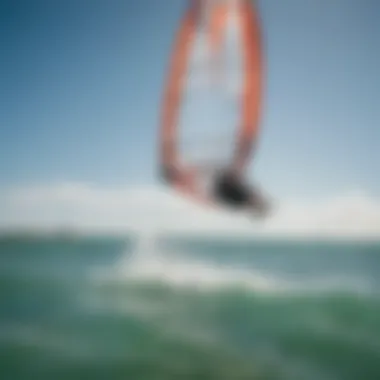

Keeping a watchful eye on our actions can prevent the sport we love from harming the ecosystems we cherish.
Sustainable Practices for Enthusiasts
Now, let’s talk about what kite surfers can do to protect these precious environments while enjoying their passion. Embracing sustainability isn’t merely a nice idea; it’s a necessary practice for the longevity of kite surfing and the health of our coasts. Here’s how enthusiasts can contribute positively:
- Choose Eco-Friendly Gear: Opt for brands that focus on sustainability in their manufacturing processes. Materials that minimize the environmental footprint are becoming more available.
- Respect Marked Areas: Adhere to signs and guidelines indicating protected nesting areas or sensitive habitats to avoid disturbances.
- Participate in Clean-Up Days: Many local kite surfing communities organize events to clean up beaches. Getting involved not only helps the environment but fosters a sense of community.
- Educate Others: Share knowledge about the importance of protecting local ecosystems with fellow enthusiasts. Awareness goes a long way in shaping responsible practices.
- Stay Informed on Regulations: Understanding local laws regarding wildlife protection and marine areas can help practitioners navigate responsibly.
Kite surfing should be a harmonious relationship with nature. By taking steps to ensure our practices are sustainable, we can continue to enjoy the sport and protect the beautiful environments that make Florida a kite surfing paradise.
Community and Culture of Kite Surfing in Florida
Kite surfing in Florida isn't just about the exhilarating rush of riding the waves or mastering the gusty winds; it's deeply ingrained in the vibe of the local community and culture. The essence of this sport is amplified within connections that bind enthusiasts together. Events, competitions, and social gatherings knit a tighter community, providing support and encouragement for both novices and seasoned riders. Understanding and participating in this culture enhances one’s appreciation of the sport and fosters lifelong friendships.
Local Events and Competitions
Throughout Florida, kite surfing competitions and events punctuate the calendar, from casual meetups at neighborhood beaches to championship competitions that draw national attention. For example, the Florida Kiteboarding Association hosts annual events that showcase talent while offering a platform for riders to display their skills and push their limits. These events are not just for serious contenders; they also welcome spectators and newcomers, creating an atmosphere of inclusivity.
The excitement of watching talented kite surfers perform tricks like spins, jumps, and flips is infectious. Local events often morph into community festivals where food trucks, music, and workshops abound. Such gatherings provide newbies an opportunity to learn from experienced kiteboarders who are eager to share their knowledge. The buzz in the air during competitions is palpable, making everyone feel like part of a larger family united by a passion for the sport.
"Events are where the magic happens. You can feel the energy, a true testament to the love for kite surfing here in Florida."
Connecting with Other Enthusiasts
The collective spirit of kite surfers in Florida is fostered through various platforms and clubs, allowing enthusiasts to connect and engage with one another. Social media serves as a vital hub for sharing experiences, tips, and stories. Groups on platforms like Facebook host discussions where both seasoned riders and newbies post questions, share photos, or coordinate meetups. This camaraderie translates to a more engaging experience, as riders forge friendships linked by shared experiences on the water.
Additionally, kite surfing clubs and schools often host clinics and workshops, giving enthusiasts access to expert instruction while building a sense of community. Learning alongside other novice kite surfers creates bonds and a supportive environment that turns individuals into confident riders.
Local forums on Reddit can also be a goldmine for advice and camaraderie, connecting riders from all corners of the state.
In essence, the community and culture surrounding kite surfing in Florida enrich the experience. By participating in events and connecting with other enthusiasts, riders not only develop their skills but also contribute to a vibrant and supportive network that celebrates the joy of kite surfing.
Resources for Continued Learning
In the ever-evolving sport of kite surfing, continual personal and technical advancement is key to enjoying the thrills it offers and to maximizing one’s skills on the water. By seeking out quality resources for learning, kiteboarders can uncover deeper insights into their gear, refine their techniques, and stay informed about trends and best practices within the community. Engaging with various types of materials not only bolsters one’s kite surfing capabilities but also helps in nurturing a passionate involvement in the sport.
Kite surfing isn’t just a physical activity; it’s a fluid integration of art, science, and culture. By considering further educational opportunities, enthusiasts can connect the dots between physical prowess and theoretical knowledge. Here are some well-regarded paths for continued learning:
Recommended Reading and Online Courses
Delving into books and online courses can shed light on various aspects of kite surfing. Here are some effective resources to look into:
- Books:
- Online Courses:
- The Complete Guide to Kite Surfing by A. J. Parnell explores the fundamentals to advanced maneuvers, making it a go-to for all skill levels.
- Kite Surfing: The Ultimate Guide by K. J. Reilly offers perspective on technique as well as safety practices.
- Websites like Skillshare and Udemy offer kite surfing courses that cater to different skill levels. These can provide learners with structured learning paths.
- Additional resources such as YouTube have comprehensive tutorials on various techniques, guiding viewers from beginner varieties to more complex stunts.
Advantages:
Taking time to read up can provide a theoretical backdrop to practical activities. Courses, especially video ones, visually demonstrate maneuvers which can be replicated.
Joining Clubs and Organizations
Participating in clubs or organizations plays a major role in the kite surfing scene in Florida. Locally, the community often provides invaluable support and experiences that can greatly enhance one’s skill level. Here’s why joining a club can be beneficial:
- Networking Opportunities: Whether you’re a rookie or a seasoned pro, being part of a club introduces you to like-minded individuals who share your enthusiasm. These connections can lead to mentorship opportunities, friendships, or even collaborations on local events.
- Skill Development: Many clubs offer workshops, training sessions, and competitions tailored for different skills. For example, the Florida Kiteboarding Association organizes events that not only foster competition but also provide a platform for skill refinement.
- Safety and Advocacy: Clubs and organizations often champion safety initiatives and environmental advocacy, making them a fantastic resource for responsible practices within the sport. This ensures that you’re not only improving your skills but also protecting the environments in which you surf.
In sum, embracing the pursuit of knowledge through reading and community involvement paves the way for greater enjoyment and proficiency in kite surfing. It’s about building deeper connections within the kiteboarding world while sharpening your edge on the water.
Future of Kite Surfing in Florida
Kite surfing has become more than just a hobby in Florida; it's a growing community and industry. Understanding its future allows enthusiasts to prepare for shifts in technology, trends, and even regulations that can pull the rug from under or propel the sport to new heights. As evolution often mirrors adaptation, kite surfers must keep their ears to the ground.
Trends in Equipment and Techniques
The equipment used in kite surfing has witnessed substantial advancements. Older kites have made way for lighter, more durable materials that not only enhance performance but also make the sport more accessible. For instance, brands like Cabrinha and Naish are pushing the envelope, producing kites that allow for easier launches and landings.
Key Equipment Trends:
- Smart Kites: Innovations like inflatable kites with adjustable power settings give users greater control and adjustability.
- Eco-friendly Materials: Sustainability is at the forefront of new kitesurfing gear, with companies now focusing on creating gear from recyclable materials, thus decreasing the sport's environmental footprint.
- Adaptive Equipment: Adaptive kiteboarding gear caters to surfers with disabilities, promoting inclusivity and encouraging broader participation in the sport.
Mastering new techniques is equally crucial. Kite surfers are now focusing on more dynamic moves, such as the handle pass and kite loop, which demand both skill and newer equipment to enhance execution. The community actively shares insights through platforms like Reddit, enhancing collective learning and bringing various kite styles into the realms of possibility.
Evolving Environmental Policies
The increasing popularity of kite surfing raises environmental concerns that cannot be ignored. Many local governments in Florida are beginning to impose regulations aimed at protecting coastal habitats and ensuring safety both for the surfers and the ecosystems they participate in. For instance, designated kite zones are evolving, which may directly influence where kite surfers can practice.
Considerations for the Future:
- Noise Restrictions: Some areas may implement limits on the noise produced by kite equipment, which could impact locations traditionally seen as kite surfing hotspots.
- Wildlife Protection: Laws may emerge to protect sensitive coastal wildlife, like nesting sea turtles, which can directly modify kite surfing areas during certain seasons.
- Community Engagement: More involvement from kite surfers in environmental initiatives will likely be required. Working with local ecologists and government bodies can not only safeguard kite surfing locations but also create educational platforms to raise awareness about responsible surfing practices.
"The future of kite surfing lies not just in the new tricks we perform in waves but in how we adapt our sport to preserve the very environment we love to ride in."
Navigating through a changing landscape, enthusiasts will need to stay informed, ready to adjust to the waves of change. Embracing sustainable practices, investing in eco-friendly gear, and supporting responsible policies will be crucial waypoints on the journey ahead. By acknowledging these trends, the kite surfing community in Florida can foster a thriving sport that respects both the thrill of the ride and the natural beauty surrounding it.






